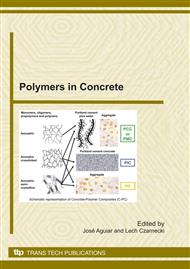[1]
N.S. Berke, M.P. Dallaire, M.C. Hicks, and A. Kerkar: New developments in Shrinkage-Reducing Admixtures. In CANMET/ACI Fifth International Conference on Superplasticizers and Other Chemical Admixtures in Concrete, Rome, Italy, (1997), pp.971-978.
DOI: 10.14359/6222
Google Scholar
[2]
S.P. Shah, M.E. Karaguler and M. Sarigaphuti: Effects of Shrinkage-Reducing Admixtures on Restrained Shrinkage Cracking of Concrete. ACI Materials Journal, No. 89-M33, May-June, (1992), pp.289-295.
DOI: 10.14359/2593
Google Scholar
[3]
K.J. Folliard and N.S. Berke: Properties Of High-Performance Concrete Containing Shrinkage-Reducing Admixture. Cement and Concrete Research, 27(9), (1997), pp.1357-1364.
DOI: 10.1016/s0008-8846(97)00135-x
Google Scholar
[4]
A.B. Ribeiro, A. Carrajola, and A. Gonçalves: Effectiveness of shrinkage reduction admixtures on different concrete mixtures. In V.M. Malhotra (ed. ), CANMET/ACI Seventh International Conference on Superplasticizers and Other Chemical Admixtures in Concrete, Berlin, Germany, October (2003).
DOI: 10.14359/12921
Google Scholar
[5]
A.B. Ribeiro, A. Carrajola, and A. Gonçalves: Behavior of mortars with different dosages of shrinkage reducing admixtures. In V.M. Malhotra (ed. ), CANMET/ACI Eight International Conference on Superplasticizers and Other Chemical Admixtures in Concrete, Sorrento, ITALY, October (2006).
DOI: 10.14359/18372
Google Scholar
[6]
A.W. Adamson, and A.P. Gast: Physical Chemistry of Surfaces, 6th Edition, (1997), New York: Wiley-Interscience, John Wiley & Sons, Inc.
Google Scholar
[7]
H.J.H. Brouwers: The work of Powers and Brownyard revisited: part 2. Cement and Concrete Research, 35, (2005), p.1922-(1936).
DOI: 10.1016/j.cemconres.2005.04.009
Google Scholar
[8]
F. Rajabipoura, G. Santb, and J. Weiss: Interactions between shrinkage reducing admixtures (SRA) and cement paste's pore solution. Cement and Concrete Research, 38(5), (2008), pp.606-615.
DOI: 10.1016/j.cemconres.2007.12.005
Google Scholar
[9]
L.J. Parrot, M. Geiker, W.A. Gutteridge and D. Killoh: Monitoring Portland Cement Hydration: Comparison of Methods. Cement and Concrete Research, 20, (1990), pp.919-926.
DOI: 10.1016/0008-8846(90)90054-2
Google Scholar
[10]
H.J.H. Brouwers: The work of Powers and Brownyard revisited: Part 1. Cement and Concrete Research, 34, (2004), pp.1697-1716.
DOI: 10.1016/j.cemconres.2004.05.031
Google Scholar


